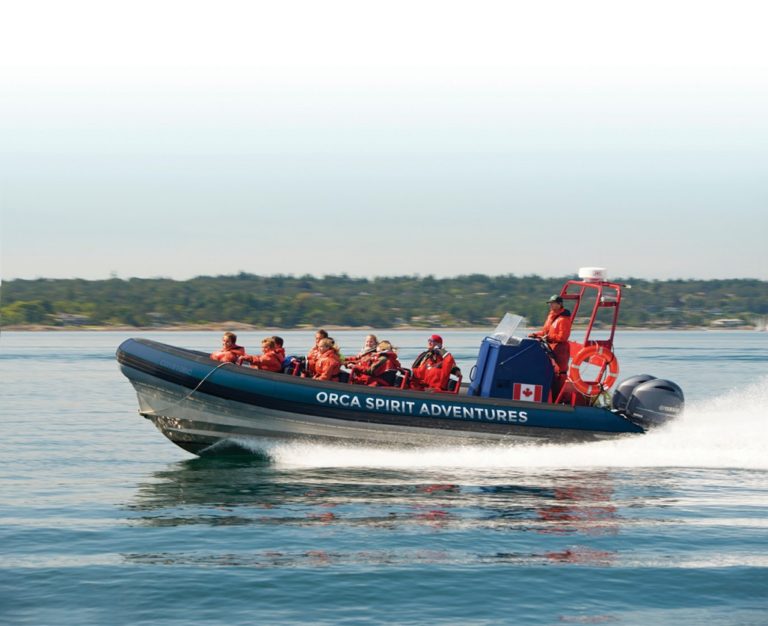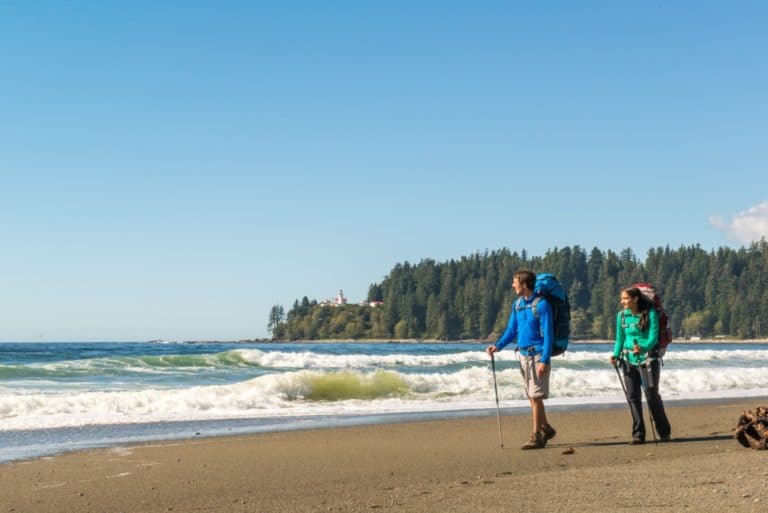Parks & Beaches
Botanical Beach
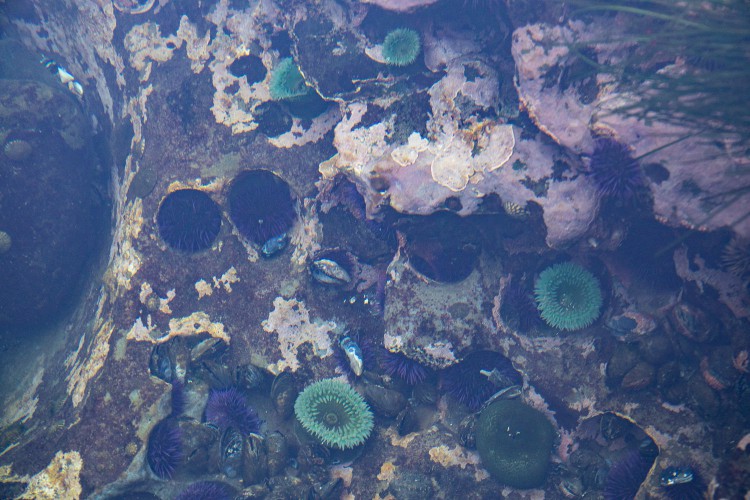
The Botanical Beach parking lot is the western terminus of the Juan de Fuca Marine Trail, located at Kilometer 47. This parking lot provides access to nearby Botany Bay and Botanical Beach itself.
Botanical Beach affords visitors with access to uniquely rich tide pools and shoreline trails with fantastic geological features. The extensive variety of marine flora and fauna in this colourful intertidal zone includes red, purple and orange starfish and sea urchins, white gooseneck barnacles, blue mussels and green sea anemones and sea cucumbers. Coralline algae, periwinkles, chitons and sea stars can also be seen at Botanical Beach.
The region is so biologically significant that the University of Minnesota installed the first marine research station in the Pacific Northwest at Botanical Beach in 1901. Since then, the area has been used for research by a number of universities in BC and Washington.
A low tide of 1.2 meters or less is best for viewing these tide pools (Port Renfrew tides).
Impact of human activity on the intertidal area is of growing concern. When visiting Botanical Beach, please look in the tide pools only – do not touch the marine life. Do not remove, collect or disturb any tide pool life, shells, plants, flowers, kelp, etc. – they are all part of a vulnerable ecosystem that Botanical Beach was established to protect. Even touching the water in a tide pool with sunscreen on your hands can create an “oil slick” that could kill the vulnerable creatures in this sensitive ecosystem. Photographs make great souvenirs.
The Botanical Beach day-use area offers parking, pit toilets, visitor information and picnic areas. While hiking on the trail, cars can be left overnight in the Botanical Beach parking lot. Please do not leave anything of value in your vehicle.
Source: BC Parks
Avatar Grove
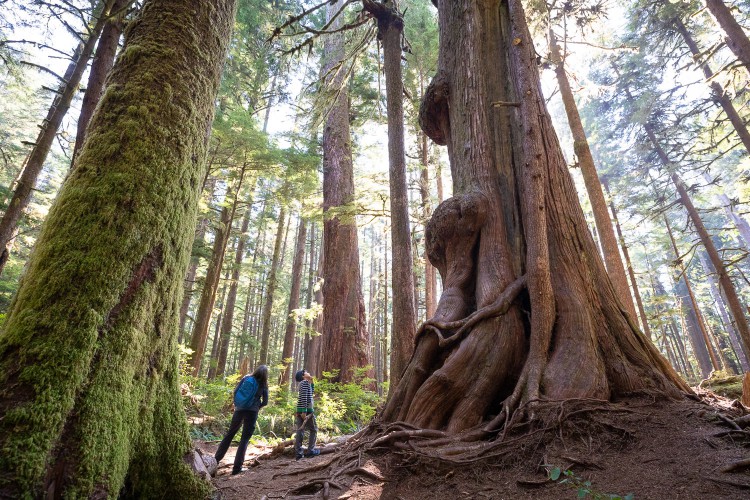
“Avatar Grove” is a popular nickname for the Pacheedaht name of “T’l’oqwxwat” and is in the unceded territory of the Pacheedaht First Nation. It was protected by the BC government in 2012 after an intense two-year public awareness campaign led by the AFA in partnership with the Port Renfrew Chamber of Commerce. Please support the local business community whenever possible and be sure to treat the land and all creatures with respect. Pack it in/pack it out. Note: camping is not permitted at Avatar Grove.
- Drive to Port Renfrew along West Coast Rd / Highway #14
- Immediately upon reaching Port Renfrew turn RIGHT onto Deering Rd.
- Cross the big bridge over the San Juan River and continue down Deering Rd., staying to the RIGHT at the next Y
- You’ll cross a small, single lane bridge and reach a “T”. Turn LEFT onto Gordon River Main (right goes to Lake Cowichan)
- Stay on the mostly-paved road and after approximately 5 km, you will reach a “Y”. Go LEFT and cross a tall, beautiful bridge over the Gordon River
- After crossing the bridge, stay on Gordon River Main (now a bumpy gravel road) for about 1.5 km, keeping to the RIGHT at the next “Y”
- You will soon cross a small bridge at Baird Creek. Park on the right side after the bridge. Look for signs at the trailheads
- The trail on the right hand side will take you into the Lower Grove which is flatter and has some giant, burly cedars and large Douglas-fir trees
- The trail on the left side of the road takes you through the Upper Grove, where, at the top, you’ll see “Canada’s Gnarliest Tree”! This side is a bit steeper and has many large cedar trees alongside the path”
Source: Ancient Forest Alliance
Red Creek Fir
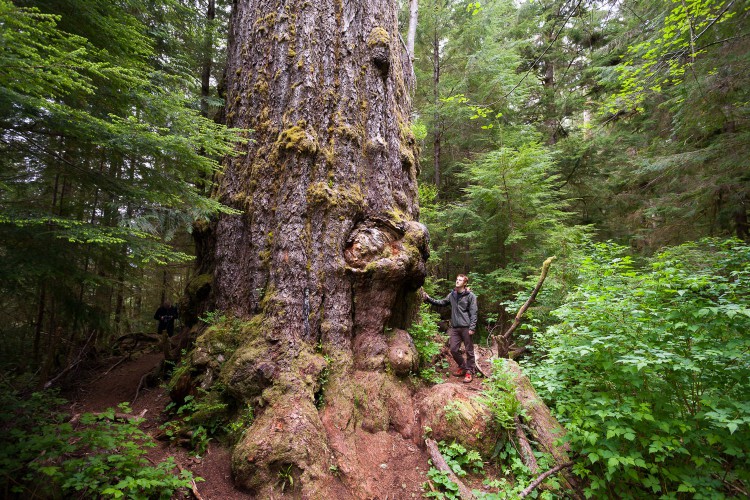
The San Juan and Gordon Rivers converge at the foot of Port San Grey whole in estuary (II. Chester) Juan bay. The proximity to the Pacific and local high relief results in a mild and wet maritime climate. This has created ideal conditions for vegetation to grow and the result, after millennia, is that the San Juan Valley has deep rich soils. The presence of the giant Red Creek Fir is a testament to these superb growing conditions. Said to be Canada’s largest standing Fir Tree, the Red Creek fir is estimated to be 750 years to 1,000 years old.
Stats:
Height – 73.8 m (242’)
Circumference -12.55 m (41’2”)
Crown – 22.9 m (75’)
Located 2.5 km outside of Port Renfrew, the Red Creek fir is accessible by four wheel drive only.
Carmanah-Walbran Provincial Park
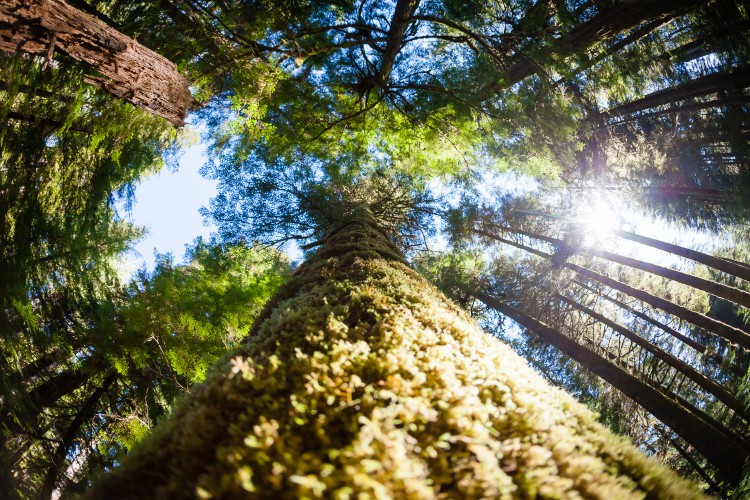
“Carmanah Walbran Provincial Park is a luxuriously forested sanctuary that is without a doubt one of the most remarkable wild places on Vancouver Island. The lower Carmanah Valley was declared a provincial park in 1990, and the Walbran and upper Carmanah Valleys were added in 1995. The park offers protection to diverse forest ecosystems, including a large Sitka spruce ecosystem that represents 2% of BC’s remaining old-growth forest.
Carmanah Walbran is home to some of the world’s largest spruce trees, some reaching heights in excess of 95 metres and living for 800 years or more. The park is also home to ancient, gnarled cedars – estimated to be well over 1,000 years old – clinging to the side hills. Nestled beneath these awe-inspiring trees is a diverse variety of flora and fauna possible only in an ecosystem that has remained undisturbed for hundreds of years.
The recent addition of the Walbran and upper Carmanah Valleys completes the protection of the Carmanah Creek watershed and the southern portion of the Walbran Creek watershed. The park provides unique opportunities for forest research and education in the areas of biodiversity, wildlife and fisheries habitat. It is a majestic forest capable of inspiring all visitors who come here, and offers unforgettable recreational opportunities for hikers and wilderness lovers.
This coastal fringe of mainly Sitka spruce, with its associated plants and animals, is truly a special place to discover. Sitka spruce forests are typically coast-hugging – they are rarely found more than 80 kilometres inland and at elevations greater than 30 metres. The park’s extensive groves of spruce attain a biomass (weight of plants per hectare) that is nearly twice that of a tropical forest. This dynamic system has developed over thousands of years and functions perfectly if left undisturbed.
Several hiking trails in the Carmanah Valley provide access to many of the park’s notable natural features, including some of the area’s largest trees. Many sections of the trail are extremely muddy and difficult. Be equipped with appropriate clothing (including adequate rain gear) and good hiking boots.”
Source: BC Parks
Sombrio Beach
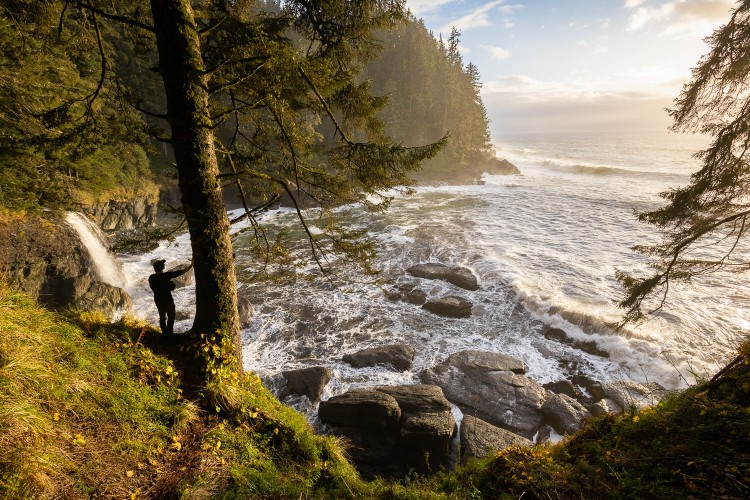
“Located at approximately Kilometer 29 of the Juan de Fuca Marine Trail, the large cobbled Sombrio Beach can be reached via a 250-meter access trail from the Sombrio Beach Trailhead parking lot, off Hwy 14. There are two designated wilderness camping areas at Sombrio Beach; one at East Sombrio and one at West Sombrio.
Visitors can explore or hike east or west along the beach, enjoy a picnic or try their hand at surfing in this world-class surfing area. Sombrio Beach is part of the Juan de Fuca Marine Trail, so please respect trail hikers. Parkinson Creek is approximately 9 km west of Sombrio Beach; the nearest trailhead to the east is the Juan de Fuca East (China Beach) Trailhead at Kilometer 0.”
Source: BC Parks
Parkinson Creek
Parkinson Creek Trailhead is located at Kilometer 37.6 of the Juan de Fuca Marine Trail. From here you can hike east to Sombrio or west to Botanical Beach. There are 2 campsites nearby – Payzant Creek at Kilometer 40 and Little Kuitsche Creek at Kilometer 33.5.
This moderate section of trail takes hikers through regenerating logged areas and old growth forest fringe and along the beautiful rugged shoreline. Watch for marine mammals that frequent this area.
Source: BC Parks
China Beach
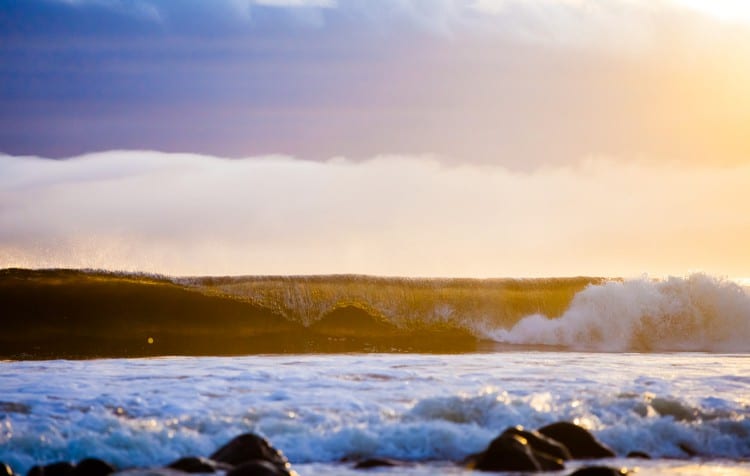
China Beach day-use area is a spectacular spot for family outings and day trips, 35 km west of Sooke and 36 km east of Port Renfrew. The 15-20 minute hike (each way) through the mature forest of Sitka spruce, Douglas fir and Western red cedar leads visitors to the great rolling breakers of a tumultuous sea.
The fine sand beach is ideal for picnicking, sandcastle building, wading and relaxing. Take a short walk to the western end of the beach to the waterfall or wander at length to the east. It is possible to walk along the beach between China Beach and Second Beach.
In the spring and fall, look for the magnificent grey whale offshore as it travels along its migratory route. As many as 17,000 of these mammoth creatures travel down the coast throughout the migration period; some, in fact, spend the summer off the shores of Vancouver Island.
There are 78 drive-in campsites available at this campground. Campsite reservations are accepted and first-come, first-served sites are also available. Some facilities are wheelchair accessible; pit toilets and water taps are located throughout the campground. There are no showers facilities and no sani-station/dump facilities at this park. Closest sani-station located at French Beach Provincial Park. No cycling on park trails; cycling is permitted on the campground road network only.
Source: BC Parks

